目录
Linear Control System Analysis and Design with Matlab, Fifth Edition, Revised and Expanded
Series Introduction
Preface
Contents
ch01
LINEAR CONTROL SYSTEM ANALYSIS AND DESIGN WITH MATLAB: FIFTH EDITION, REVISED AND EXPANDED
Table of Contents
Chapter 1: Introduction
1.1 INTRODUCTION
1.2 INTRODUCTION TO CONTROL SYSTEMS
Classical Examples
Modern Examples
1.3 DEFINITIONS
1.4 HISTORICAL BACKGROUND [12]
1.5 DIGITAL CONTROL DEVELOPMENT [16]
1.6 MATHEMATICAL BACKGROUND
1.7 THE ENGINEERING CONTROL PROBLEM
1.8 COMPUTER LITERACY
1.9 OUTLINE OF TEXT
REFERENCES
ch02
LINEAR CONTROL SYSTEM ANALYSIS AND DESIGN WITH MATLAB: FIFTH EDITION, REVISED AND EXPANDED
Table of Contents
Chapter 2: Writing System Equations
2.1 INTRODUCTION
2.2 ELECTRIC CIRCUITS AND COMPONENTS [6]
Series Resistor–Inductor Circuit
Series Resistor–Inductor–Capacitor Circuit
Multiloop Electric Circuits
2.3 STATE CONCEPTS
2.4 TRANSFER FUNCTION AND BLOCK DIAGRAM
2.5 MECHANICAL TRANSLATION SYSTEMS [1,8,9]
Simple Mechanical Translation System
Multiple-Element Mechanical Translation System
2.6 ANALOGOUS CIRCUITS
2.7 MECHANICAL ROTATIONAL SYSTEMS
Simple Mechanical Rotational System
Multiple-Element Mechanical Rotational System
2.8 EFFECTIVE MOMENT OF INERTIA AND DAMPING OF A GEAR TRAIN
2.9 THERMAL SYSTEMS [11]
Simple Mercury Thermometer
2.10 HYDRAULIC LINEAR ACTUATOR
Simplified Analysis
More Complete Analysis
2.11 LIQUID-LEVEL SYSTEM [12,13]
2.12 ROTATING POWER AMPLIFIERS [14,15]
2.13 DC SERVOMOTOR
2.14 AC SERVOMOTOR [16]
2.15 LAGRANGE’S EQUATION
2.16 SUMMARY
REFERENCES
ch03
LINEAR CONTROL SYSTEM ANALYSIS AND DESIGN WITH MATLAB: FIFTH EDITION, REVISED AND EXPANDED
Table of Contents
Chapter 3: Solution of Differential Equations
3.1 INTRODUCTION
3.2 STANDARD INPUTS TO CONTROL SYSTEMS
3.3 STEADY-STATE RESPONSE: SINUSOIDAL INPUT
3.4 STEADY-STATE RESPONSE: POLYNOMIAL INPUT
Step-Function Input
Ramp-Function Input (Step Function of Velocity)
Parabolic-Function Input (Step Function of Acceleration)
3.5 TRANSIENT RESPONSE: CLASSICAL METHOD
Complex Roots
Damping Ratio z and Undamped Natural Frequency vn
3.6 DEFINITION OF TIME CONSTANT
3.7 EXAMPLE: SECOND-ORDER SYSTEM—MECHANICAL
3.8 EXAMPLE: SECOND-ORDER SYSTEM—ELECTRICAL
3.9 SECOND-ORDER TRANSIENTS [2]
Response Characteristics
3.10 TIME-RESPONSE SPECIFICATIONS [3]
3.11 CAD ACCURACY CHECKS (CADAC)
3.12 STATE-VARIABLE EQUATIONS [5–8]
3.13 CHARACTERISTIC VALUES
3.14 EVALUATING THE STATE TRANSITION MATRIX
3.15 COMPLETE SOLUTION OF THE STATE EQUATION [10]
3.16 SUMMARY
REFERENCES
ch04
LINEAR CONTROL SYSTEM ANALYSIS AND DESIGN WITH MATLAB: FIFTH EDITION, REVISED AND EXPANDED
Table of Contents
Chapter 4: Laplace Transform
4.1 INTRODUCTION
4.2 DEFINITION OF THE LAPLACE TRANSFORM
4.3 DERIVATION OF LAPLACE TRANSFORMS OF SIMPLE FUNCTIONS
Step Function u 1(t)
Decaying Exponential e a t
Ramp Function u 2 ðtÞ ¼ tu 1ðtÞ
4.4 LAPLACE TRANSFORM THEOREMS
4.5 CAD ACCURACY CHECKS: CADAC
4.6 APPLICATION OF THE LAPLACE TRANSFORM TO DIFFERENTIAL EQUATIONS
4.7 INVERSE TRANSFORMATION
4.8 HEAVISIDE PARTIAL-FRACTION EXPANSION THEOREMS
Case 1: First-Order Real Poles
Case 2: Multiple-Order Real Poles
Case 3: Complex-Conjugate Poles
Case 4: Multiple-Order Complex Poles
4.9 MATLAB PARTIAL-FRACTION EXAMPLE
The PARTFRAC Command
4.10 PARTIAL-FRACTION SHORTCUTS
4.11 GRAPHICAL INTERPRETATION OF PARTIAL-FRACTION COEFFICIENTS [7]
4.12 FREQUENCY RESPONSE FROM THE POLE-ZERO DIAGRAM
4.13 LOCATION OF POLES AND STABILITY
4.14 LAPLACE TRANSFORM OF THE IMPULSE FUNCTION
4.15 SECOND-ORDER SYSTEM WITH IMPULSE EXCITATION
4.16 SOLUTION OF STATE EQUATION [9,10]
4.17 EVALUATION OF THE TRANSFER-FUNCTION MATRIX
4.18 MATLAB m-FILE FOR MIMO SYSTEMS
4.19 SUMMARY
REFERENCES
ch05
LINEAR CONTROL SYSTEM ANALYSIS AND DESIGN WITH MATLAB: FIFTH EDITION, REVISED AND EXPANDED
Table of Contents
Chapter 5: System Representation
5.1 INTRODUCTION
5.2 BLOCK DIAGRAMS
Example 1: A Temperature Control System.
Example 2: Command Guidance Interceptor System.
Example 3: Aircraft Control System [1].
5.3 DETERMINATION OF THE OVERALL TRANSFER FUNCTION
Example: Overall Transfer Function
5.4 STANDARD BLOCK DIAGRAM TERMINOLOGY [2]
Definitions: Variables in the System
Definitions: System Components
5.5 POSITION CONTROL SYSTEM
5.6 SIMULATION DIAGRAMS [3,4]
5.7 SIGNAL FLOW GRAPHS [8,9]
Flow-Graph Definitions
Flow-Graph Algebra
General Flow-Graph Analysis
The Mason Gain Rule
5.8 STATE TRANSITION SIGNAL FLOW GRAPH [10]
5.9 PARALLEL STATE DIAGRAMS FROM TRANSFER FUNCTIONS
5.10 DIAGONALIZING THE A MATRIX [11,12]
Method 1: Matrix A in Companion Form
Method 2: Adjoint Method
Method 3: Simultaneous Equation Method
Method 4: Reid’s Method [13]
Method 5: Eigenvector Method
Method 6: Using MATLAB
5.11 USE OF STATE TRANSFORMATION FOR THE STATE EQUATION SOLUTION
5.12 TRANSFORMING A MATRIX WITH COMPLEX EIGENVALUES
5.13 TRANSFORMING AN A MATRIX INTO COMPANION FORM
5.14 USING MATLAB TO OBTAIN THE COMPANION A MATRIX
5.15 SUMMARY
REFERENCES
ch06
LINEAR CONTROL SYSTEM ANALYSIS AND DESIGN WITH MATLAB: FIFTH EDITION, REVISED AND EXPANDED
Table of Contents
Chapter 6: Control-System Characteristics
6.1 INTRODUCTION
6.2 ROUTH’S STABILITY CRITERION [2–5]
6.3 MATHEMATICAL AND PHYSICAL FORMS
6.4 FEEDBACK SYSTEM TYPES
6.5 ANALYSIS OF SYSTEM TYPES
Case 1: m¼0 (Type 0 System)
Case 2: m¼1 (Type 1 System)
Case 3: m¼2 (Type 2 System)
6.6 EXAMPLE: TYPE 2 SYSTEM
6.7 STEADY-STATE ERROR COEFFICIENTS [9]
Steady-State Step Error Coefficient
Steady-State Ramp Error Coefficient
Steady-State Parabolic Error Coefficient
6.8 CAD ACCURACY CHECKS: CADAC
6.9 USE OF STEADY-STATE ERROR COEFFICIENTS
Type 1 System
Table of Steady-State Error Coefficients
Polynomial Input: tmQ1
6.10 NONUNITY-FEEDBACK SYSTEM
6.11 SUMMARY
REFERENCES
ch07
LINEAR CONTROL SYSTEM ANALYSIS AND DESIGN WITH MATLAB: FIFTH EDITION, REVISED AND EXPANDED
Table of Contents
Chapter 7: Root Locus
7.1 INTRODUCTION
7.2 PLOTTING ROOTS OF A CHARACTERISTIC EQUATION
7.3 QUALITATIVE ANALYSIS OF THE ROOT LOCUS
7.4 PROCEDURE OUTLINE
7.5 OPEN-LOOP TRANSFER FUNCTION
7.6 POLES OF THE CONTROL RATIO C(s)/R(s)
7.7 APPLICATION OF THE MAGNITUDE AND ANGLE CONDITIONS
WðsÞ Plane
7.8 GEOMETRICAL PROPERTIES (CONSTRUCTION RULES)
Rule 1: Number of Branches of the Locus
Rule 2: Real-Axis Locus
Rule 3: Locus End Points
Rule 4: Asymptotes of Locus as s Approaches Infinity
Rule 5: Real-Axis Intercept of the Asymptotes
Rule 6: Breakaway Point on the Real Axis [4]
Rule 7: Complex Pole (or Zero): Angle of Departure
Rule 8: Imaginary-Axis Crossing Point
Rule 9: Intersection or Nonintersection of Root-Locus Branches [5]
Rule 10: Conservation of the Sum of the System Roots
Rule 11: Determination of Roots on the Root Locus
7.9 CAD ACCURACY CHECKS (CADAC)
7.10 ROOT LOCUS EXAMPLE
7.11 EXAMPLE OF SECTION 7.10: MATLAB ROOT LOCUS
7.12 ROOT LOCUS EXAMPLE WITH AN RH PLANE ZERO
7.13 PERFORMANCE CHARACTERISTICS
General Introduction
Plot of Characteristic Roots for 0< z < 1
Variation of Roots with z
Higher-Order Systems
7.14 TRANSPORT LAG [7]
7.15 SYNTHESIS
7.16 SUMMARY OF ROOT-LOCUS CONSTRUCTION RULES FOR NEGATIVE FEEDBACK
7.17 SUMMARY
REFERENCES
ch08
LINEAR CONTROL SYSTEM ANALYSIS AND DESIGN WITH MATLAB: FIFTH EDITION, REVISED AND EXPANDED
Table of Contents
Chapter 8: Frequency Response
8.1 INTRODUCTION
8.2 CORRELATION OF THE SINUSOIDAL AND TIME RESPONSE [3]
8.3 FREQUENCY-RESPONSE CURVES
8.4 BODE PLOTS (LOGARITHMIC PLOTS)
8.5 GENERAL FREQUENCY-TRANSFER-FUNCTION RELATIONSHIPS
8.6 DRAWING THE BODE PLOTS
Constants
ju Factors
1QjuT Factors
Quadratic Factors
8.7 EXAMPLE OF DRAWING A BODE PLOT
8.8 GENERATION OF MATLAB BODE PLOTS
8.9 SYSTEM TYPE AND GAIN AS RELATED TO LOG MAGNITUDE CURVES
Type 0 Systems
Type 1 System
Type 2 System
8.10 CAD ACCURACY CHECK (CADAC)
8.11 EXPERIMENTAL DETERMINATION OF TRANSFER FUNCTION [5,9]
8.12 DIRECT POLAR PLOTS
Complex RC Network (Lag-Lead Compensator)
Type 0 Feedback Control System
Type 1 Feedback Control System
Type 2 Feedback Control System
8.13 SUMMARY: DIRECT POLAR PLOTS
8.14 NYQUIST’S STABILITY CRITERION
Limitations
Mathematical Basis for Nyquist’s Stability Criterion
Generalizing Nyquist’s Stability Criterion
Obtaining a Plot of B(s)
Analysis of Path Q
Effect of Poles at the Origin on the Rotation of B(s)
When G( ju)H( ju) Passes Through the Point 1þj0
8.15 EXAMPLES OF NYQUIST’S CRITERION USING DIRECT POLAR PLOT
8.16 NYQUIST’S STABILITY CRITERION APPLIED TO SYSTEM HAVING DEAD TIME
8.17 DEFINITIONS OF PHASE MARGIN AND GAIN MARGIN AND THEIR RELATION TO STABILITY [16]
8.18 STABILITY CHARACTERISTICS OF THE LOG MAGNITUDE AND PHASE DIAGRAM
8.19 STABILITY FROM THE NICHOLS PLOT (LOG MAGNITUDE—ANGLE DIAGRAM)
8.20 SUMMARY
REFERENCES
ch09
LINEAR CONTROL SYSTEM ANALYSIS AND DESIGN WITH MATLAB: FIFTH EDITION, REVISED AND EXPANDED
Table of Contents
Chapter 9: Closed-Loop Tracking Performance Based on the Frequency Response
9.1 INTRODUCTION
9.2 DIRECT POLAR PLOT
9.3 DETERMINATION OF Mm AND um FOR A SIMPLE SECOND-ORDER SYSTEM
9.4 CORRELATION OF SINUSOIDAL AND TIME RESPONSES [3]
9.5 CONSTANT M(u) AND a(u) CONTOURS OF C(ju)/R(ju) ON THE COMPLEX PLANE (DIRECT PLOT)
Equation of a Circle
M(u) Contours
a(u) Contours
Tangents to the M Circles
9.6 CONSTANT 1/M AND a CONTOURS (UNITY FEEDBACK) IN THE INVERSE POLAR PLANE
9.7 GAIN ADJUSTMENT OF A UNITY-FEEDBACK SYSTEM FOR A DESIRED Mm: DIRECT POLAR PLOT
9.8 CONSTANT M AND a CURVES ON THE LOG MAGNITUDE—ANGLE DIAGRAM (NICHOLS CHART) [4]
9.9 GENERATION OF MATLAB BODE AND NYQUIST PLOTS
Bode Plot
Nyquist Plot
9.10 ADJUSTMENT OF GAIN BY USE OF THE LOG MAGNITUDE–ANGLE DIAGRAM (NICHOLS CHART)
9.11 CORRELATION OF POLE-ZERO DIAGRAM WITH FREQUENCY AND TIME RESPONSES
9.12 SUMMARY
REFERENCES
ch10
LINEAR CONTROL SYSTEM ANALYSIS AND DESIGN WITH MATLAB: FIFTH EDITION, REVISED AND EXPANDED
Table of Contents
Chapter 10: Root-Locus Compensation: Design
10.1 INTRODUCTION TO DESIGN
10.2 TRANSIENT RESPONSE: DOMINANT COMPLEX POLES [1]
10.3 ADDITIONAL SIGNIFICANT POLES [4]
10.4 ROOT-LOCUS DESIGN CONSIDERATIONS
First Design
Second Design
10.5 RESHAPING THE ROOT LOCUS
10.6 CAD ACCURACY CHECKS (CADAC)
10.7 IDEAL INTEGRAL CASCADE COMPENSATION (PI CONTROLLER)
10.8 CASCADE LAG COMPENSATION DESIGN USING PASSIVE ELEMENTS
10.9 IDEAL DERIVATIVE CASCADE COMPENSATION (PD CONTROLLER)
10.10 LEAD COMPENSATION DESIGN USING PASSIVE ELEMENTS
Design Example—Lead Compensation Applied to a Type 1 System
10.11 GENERAL LEAD-COMPENSATOR DESIGN
10.12 LAG-LEAD CASCADE COMPENSATION DESIGN
Design Example—Lag-Lead Compensation Applied to a Type 1 System
10.13 COMPARISON OF CASCADE COMPENSATORS
10.14 PID CONTROLLER
10.15 INTRODUCTION TO FEEDBACK COMPENSATION
10.16 FEEDBACK COMPENSATION: DESIGN PROCEDURES
10.17 SIMPLIFIED RATE FEEDBACK COMPENSATION: A DESIGN APPROACH
10.18 DESIGN OF RATE FEEDBACK
10.19 DESIGN: FEEDBACK OF SECOND DERIVATIVE OF OUTPUT
10.20 RESULTS OF FEEDBACK COMPENSATION DESIGN
10.21 RATE FEEDBACK: PLANTS WITH DOMINANT COMPLEX POLES
10.22 SUMMARY
REFERENCES
ch11
LINEAR CONTROL SYSTEM ANALYSIS AND DESIGN WITH MATLAB: FIFTH EDITION, REVISED AND EXPANDED
Table of Contents
Chapter 11: Frequency-Response Compensation Design
11.1 INTRODUCTION TO FEEDBACK COMPENSATION DESIGN
11.2 SELECTION OF A CASCADE COMPENSATOR
11.3 CASCADE LAG COMPENSATOR
11.4 DESIGN EXAMPLE: CASCADE LAG COMPENSATION
11.5 CASCADE LEAD COMPENSATOR
11.6 DESIGN EXAMPLE: CASCADE LEAD COMPENSATION
11.7 CASCADE LAG-LEAD COMPENSATOR
11.8 DESIGN EXAMPLE: CASCADE LAG-LEAD COMPENSATION
11.9 FEEDBACK COMPENSATION DESIGN USING LOG PLOTS [1]
11.10 DESIGN EXAMPLE: FEEDBACK COMPENSATION (LOG PLOTS)
11.11 APPLICATION GUIDELINES: BASIC MINOR-LOOP FEEDBACK COMPENSATORS
11.12 SUMMARY
REFERENCES
ch12
LINEAR CONTROL SYSTEM ANALYSIS AND DESIGN WITH MATLAB: FIFTH EDITION, REVISED AND EXPANDED
Table of Contents
Chapter 12: Control-Ratio Modeling
12.1 INTRODUCTION [1]
12.2 MODELING A DESIRED TRACKING CONTROL RATIO
12.3 GUILLEMIN-TRUXAL DESIGN PROCEDURE [4]
12.4 INTRODUCTION TO DISTURBANCE REJECTION [6,7]
12.5 A SECOND-ORDER DISTURBANCE-REJECTION MODEL
Time Domain
Frequency Domain
12.6 DISTURBANCE-REJECTION DESIGN PRINCIPLES FOR SISO SYSTEMS [7]
Trial Solution
12.7 DISTURBANCE-REJECTION DESIGN EXAMPLE
12.8 DISTURBANCE-REJECTION MODELS
12.9 SUMMARY
REFERENCES
ch13
LINEAR CONTROL SYSTEM ANALYSIS AND DESIGN WITH MATLAB: FIFTH EDITION, REVISED AND EXPANDED
Table of Contents
Chapter 13: Design: Closed-Loop Pole-Zero Assignment (State-Variable Feedback)
13.1 INTRODUCTION
13.2 CONTROLLABILITY AND OBSERVABILITY [5–9]
Example: MATLAB Controllability and Observability
13.3 STATE FEEDBACK FOR SISO SYSTEMS
13.4 STATE-FEEDBACK DESIGN FOR SISO SYSTEMS USING THE CONTROL CANONICAL (PHASE-VARIABLE) FORM
13.5 STATE-VARIABLE FEEDBACK [10] (PHYSICAL VARIABLES)
13.6 GENERAL PROPERTIES OF STATE FEEDBACK (USING PHASE VARIABLES)
13.7 STATE-VARIABLE FEEDBACK: STEADY-STATE ERROR ANALYSIS
Step Input rðtÞ ¼ R0u 1ðtÞ RðsÞ ¼ R0=s
Ramp Input rðtÞ ¼ R1u 2ðtÞ ¼ R1tu 1ðtÞ RðsÞ ¼ R1=s2
Parabolic Input rðtÞ ¼ R2u 3ðtÞ ¼ ðR2t2=2Þu 1ðtÞ RðsÞ ¼ R2=s3
13.8 USE OF STEADY-STATE ERROR COEFFICIENTS
13.9 STATE-VARIABLE FEEDBACK: ALL-POLE PLANT
13.10 PLANTS WITH COMPLEX POLES
13.11 COMPENSATOR CONTAINING A ZERO
13.12 STATE-VARIABLE FEEDBACK: POLE-ZERO PLANT
13.13 OBSERVERS [12–17]
13.14 CONTROL SYSTEMS CONTAINING OBSERVERS
13.15 SUMMARY
REFERENCES
ch14
LINEAR CONTROL SYSTEM ANALYSIS AND DESIGN WITH MATLAB: FIFTH EDITION, REVISED AND EXPANDED
Table of Contents
Chapter 14: Parameter Sensitivity and State-Space Trajectories
14.1 INTRODUCTION
14.2 SENSITIVITY
Case 1: Open-Loop System of Fig. 14.1a
Case 2: Closed-Loop Unity-Feedback System of Fig. 14.1b
Case 3: Closed-Loop Nonunity-Feedback System of Fig. 14.1b [Feedback Function HðsÞ Fixed and GðsÞ Variable]
Case 4: Closed-Loop Nonunity-Feedback System of Fig. 14.1b [Feedback Function HðsÞ Variable and GðsÞ Fixed]
14.3 SENSITIVITY ANALYSIS [3,4]
14.4 SENSITIVITY ANALYSIS [3,4] EXAMPLES
14.5 PARAMETER SENSITIVITY EXAMPLES
14.6 INACCESSIBLE STATES [5]
14.7 STATE-SPACE TRAJECTORIES [6]
14.8 LINEARIZATION (JACOBIAN MATRIX) [6,7]
14.9 SUMMARY
REFERENCES
ch15
LINEAR CONTROL SYSTEM ANALYSIS AND DESIGN WITH MATLAB: FIFTH EDITION, REVISED AND EXPANDED
Table of Contents
Chapter 15: Sampled-Data Control Systems
15.1 INTRODUCTION [1–5]
15.2 SAMPLING
15.3 IDEAL SAMPLING
15.4 Z-TRANSFORM THEOREMS
15.5 DIFFERENTIATION PROCESS [1]
15.5.1 First Derivative Approximation
15.5.2 Second Derivative Approximation
15.5.3 r th Derivative Approximation
15.6 SYNTHESIS IN THE z DOMAIN (DIRECT METHOD)
15.6.1 z-Plane Stability
15.6.2 System Stability [5]
15.6.3 System Analysis
15.7 THE INVERSE Z TRANSFORM
15.8 ZERO-ORDER HOLD
15.9 LIMITATIONS
15.10 STEADY-STATE ERROR ANALYSIS FOR STABLE SYSTEMS
15.10.1 Steady-State Error-Coefficients
15.10.2 Evaluation of Steady-State Error Coefficients
15.10.3 Use of Steady-State Error Coefficients
15.11 ROOT-LOCUS ANALYSIS FOR SAMPLED-DATA CONTROL SYSTEMS
15.11.1 Procedure Outline
15.11.2 Root-Locus Construction Rules for Negative Feedback
15.11.3 Root-Locus Design Examples
15.12 SUMMARY
REFERENCES
ch16
LINEAR CONTROL SYSTEM ANALYSIS AND DESIGN WITH MATLAB: FIFTH EDITION, REVISED AND EXPANDED
Table of Contents
Chapter 16: Digital Control Systems*
16.1 INTRODUCTION [1,2]
16.2 COMPLEMENTARY SPECTRA [3]
16.3 TUSTIN TRANSFORMATION: s TO z PLANE TRANSFORMATION [1]
16.3.1 Tustin Transformation Properties
16.3.2 Tustin Mapping Properties
16.4 z-DOMAIN TO THE w- AND w0-DOMAIN TRANSFORMATIONS [1]
16.5 DIGITIZATION (DIG) TECHNIQUE
16.6 DIGITIZATION (DIG) DESIGN TECHNIQUE
16.7 THE PSUEDO-CONTINUOUS-TIME (PCT) CONTROL SYSTEM
16.7.1 Introduction to Psuedo-Continuous-Time System DIG Technique [1]
16.7.2 MATLAB Design for Sec. 16.7.1
16.7.3 Simple PCT Example
Case 1: PCT Open-Loop Control System
Case 2: PCT System’s Output Transfer Function
16.7.4 Sampled-Data Control System Example
Case 3: The DIR Approach Using the Exact Z Transformation
Case 4: The Tustin Control-Ratio Transfer Function
16.7.5 The PCT System of Fig. 16.1
16.7.6 PCT Design Summary
16.8 DESIGN OF DIGITAL CONTROL SYSTEM [1]
16.9 DIRECT (DIR) COMPENSATOR
16.10 PCT LEAD CASCADE COMPENSATION
16.10.1 MATLAB Design for Sec. 16.10
DIG (PCT) Design
DIR Design (Exact z Domain Design): T¼0.1 s
16.11 PCT LAG COMPENSATION
16.11.1 MATLAB Design for Sec. 16.11
16.12 PCT LAG-LEAD COMPENSATION
16.12.1 MATLAB Design for Sec. 16.12
16.13 FEEDBACK COMPENSATION: TRACKING
16.13.1 General Analysis
16.13.2 DIG Technique for Feedback Control
16.14 CONTROLLING UNWANTED DISTURBANCES
16.14.1 PCT DIG Technique
16.15 EXTENSIVE DIGITAL FEEDBACK COMPENSATOR EXAMPLE
16.15.1 PCT DIG Example
16.16 CONTROLLER IMPLEMENTATION [1]
16.17 SUMMARY
REFERENCES
附录A
LINEAR CONTROL SYSTEM ANALYSIS AND DESIGN WITH MATLAB: FIFTH EDITION, REVISED AND EXPANDED
Table of Contents
Appendix A: Table of Laplace Transform Pairs
附录B
LINEAR CONTROL SYSTEM ANALYSIS AND DESIGN WITH MATLAB: FIFTH EDITION, REVISED AND EXPANDED
Table of Contents
Appendix B: Matrix Linear Algebra
B.1 INTRODUCTION
B.2 MATRIX
B.3 TRANSPOSE
B.4 VECTOR
B.5 ADDITION AND SUBTRACTION OF MATRICES
B.6 MULTIPLICATION OF MATRICES
B.7 MULTIPLICATION OF A MATRIX BY A SCALAR
B.8 UNIT OR IDENTITY MATRIX
B.9 DIFFERENTIATION OF A MATRIX
B.10 INTEGRATION OF A MATRIX
B.11 ADDITIONAL MATRIX OPERATIONS AND PROPERTIES
B.12 GENERALIZED DETERMINANT
B.13 HERMITE NORMAL FORM
B.14 MATRIX INVERSION BY ROW OPERATIONS
B.15 EVALUATION OF THE CHARACTERISTIC POLYNOMIAL
B.16 LINEAR INDEPENDENCE
REFERENCES
附录C
LINEAR CONTROL SYSTEM ANALYSIS AND DESIGN WITH MATLAB: FIFTH EDITION, REVISED AND EXPANDED
Table of Contents
Appendix C: Introduction to MATLAB and Simulink
C.1 INTRODUCTION
C.2 BASICS
C.2.1 Matrices
C.2.2 Matrix Transpose
C.2.3 Range of Values
C.2.4 m-Files and MAT-Files
C.3 DEFINING SYSTEMS
C.3.1 Transfer Function Model
C.3.2 State Space Model
C.4 ANALYSIS
C.4.1 Root Locus
C.4.2 Frequency Response
C.5 SIMULATION
C.5.1 Simulink
C.6 IMPLEMENTATION OF RESULTS
附录D
LINEAR CONTROL SYSTEM ANALYSIS AND DESIGN WITH MATLAB: FIFTH EDITION, REVISED AND EXPANDED
Table of Contents
Appendix D: TOTAL-PC CAD Package
D.1 INTRODUCTION
D.2 OVERVIEW OF TOTAL-PC
D.3 QFT CAD PACKAGE
REFERENCES
习题
LINEAR CONTROL SYSTEM ANALYSIS AND DESIGN WITH MATLAB: FIFTH EDITION, REVISED AND EXPANDED
Table of Contents
Problems
部分答案
LINEAR CONTROL SYSTEM ANALYSIS AND DESIGN WITH MATLAB: FIFTH EDITION, REVISED AND EXPANDED
Table of Contents
Answers to Selected Problems

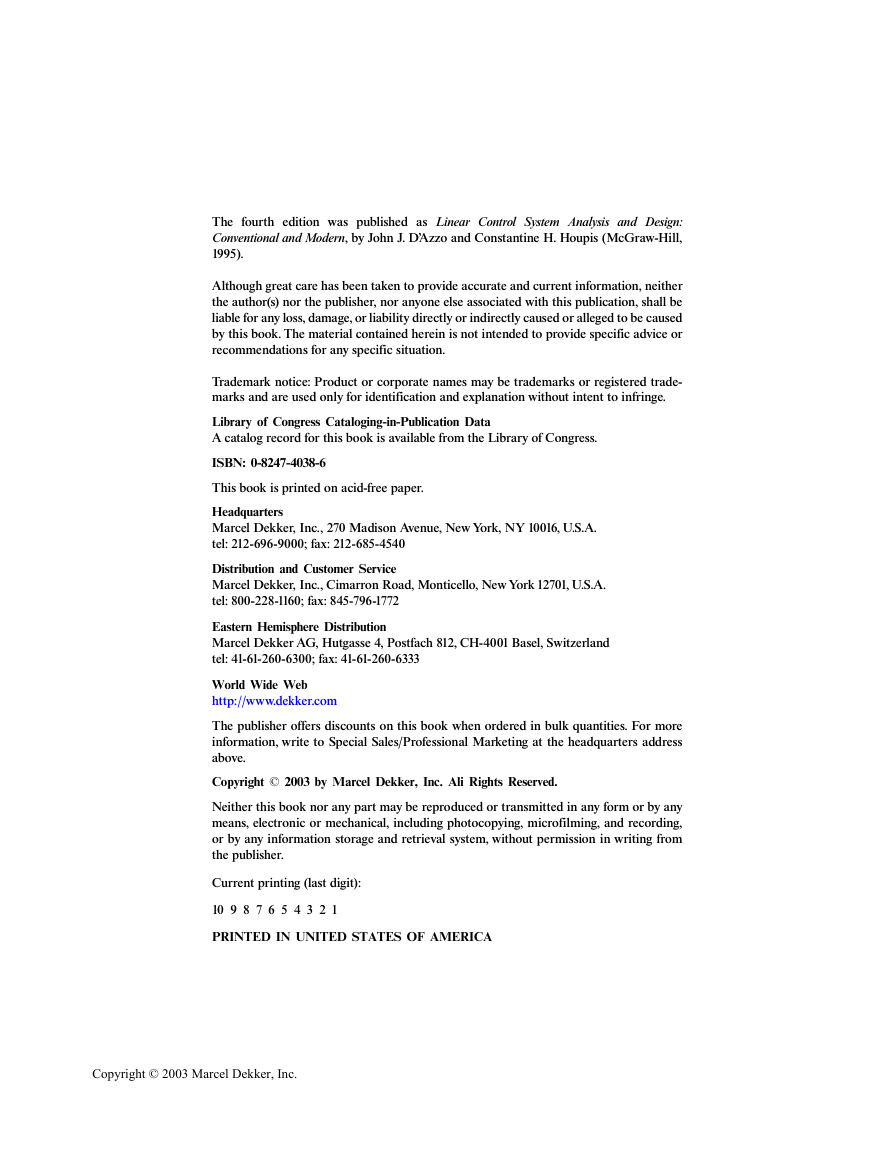
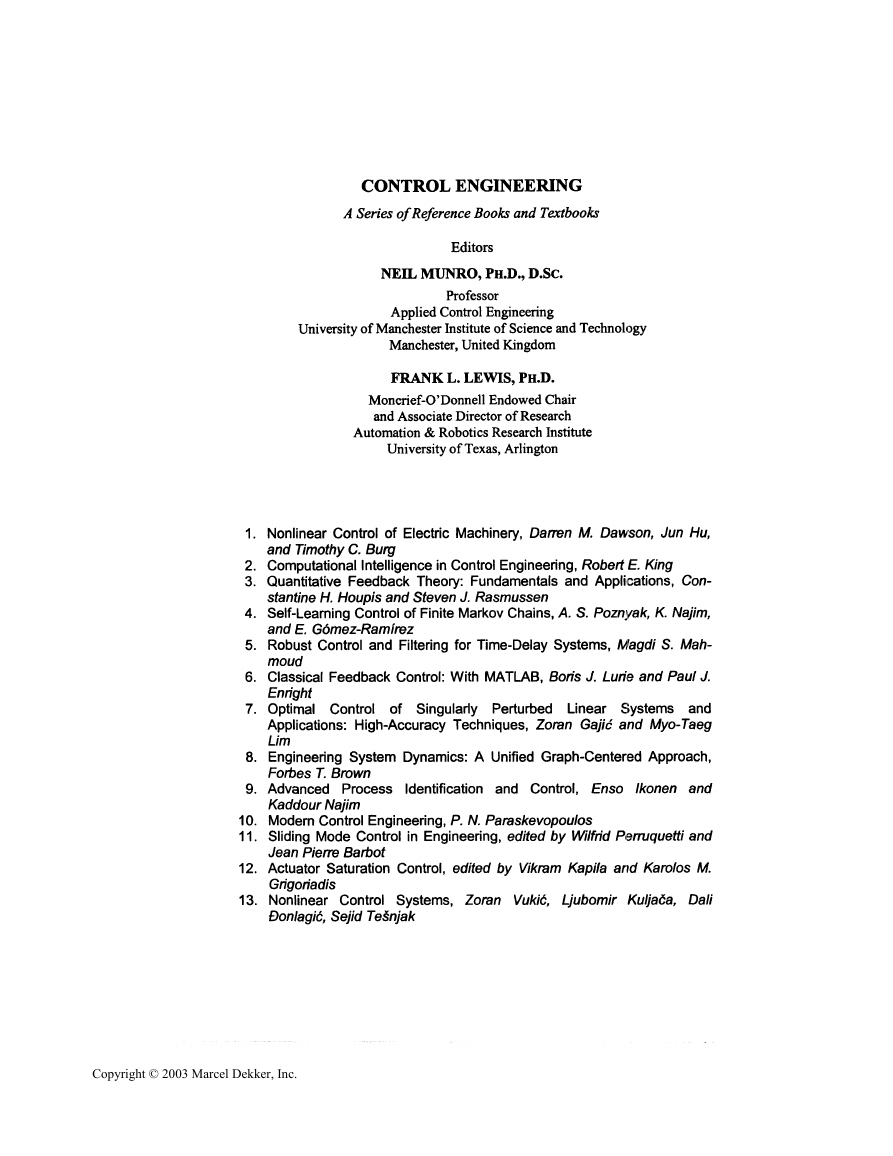
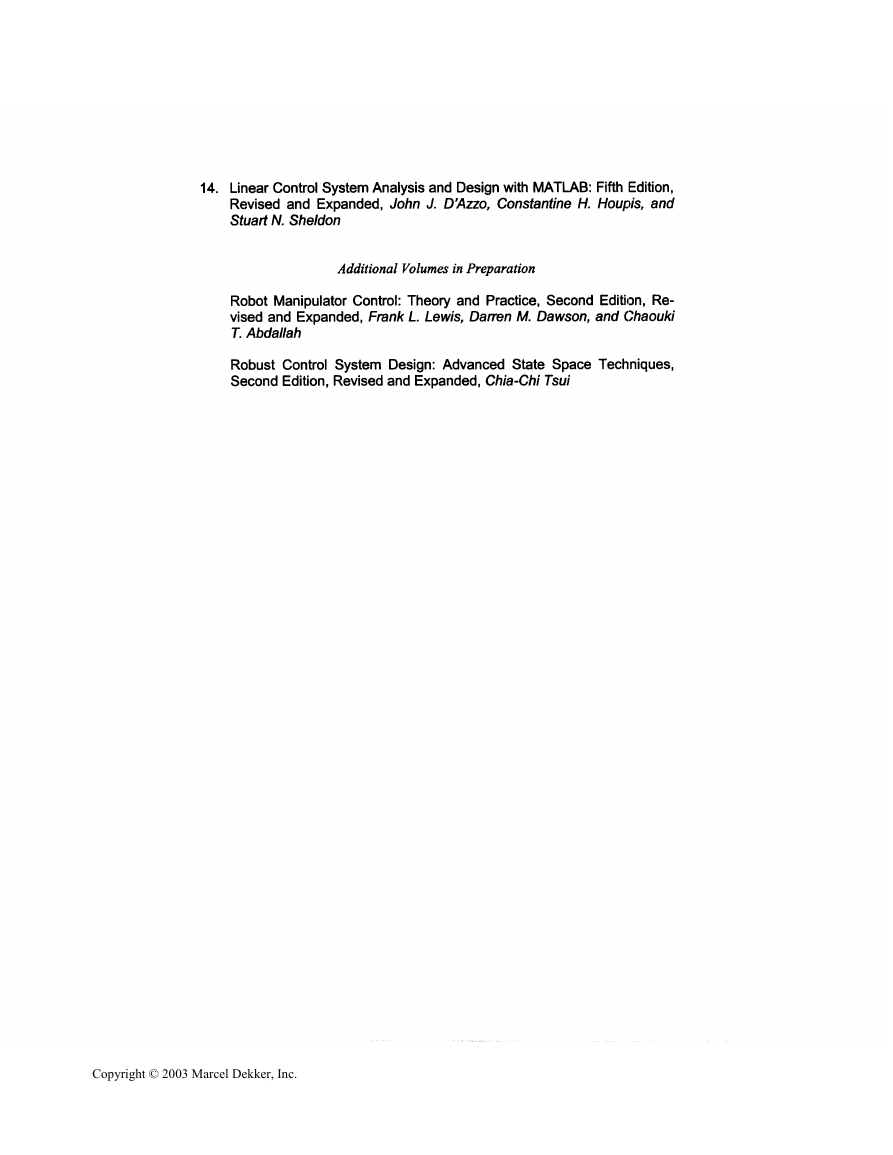
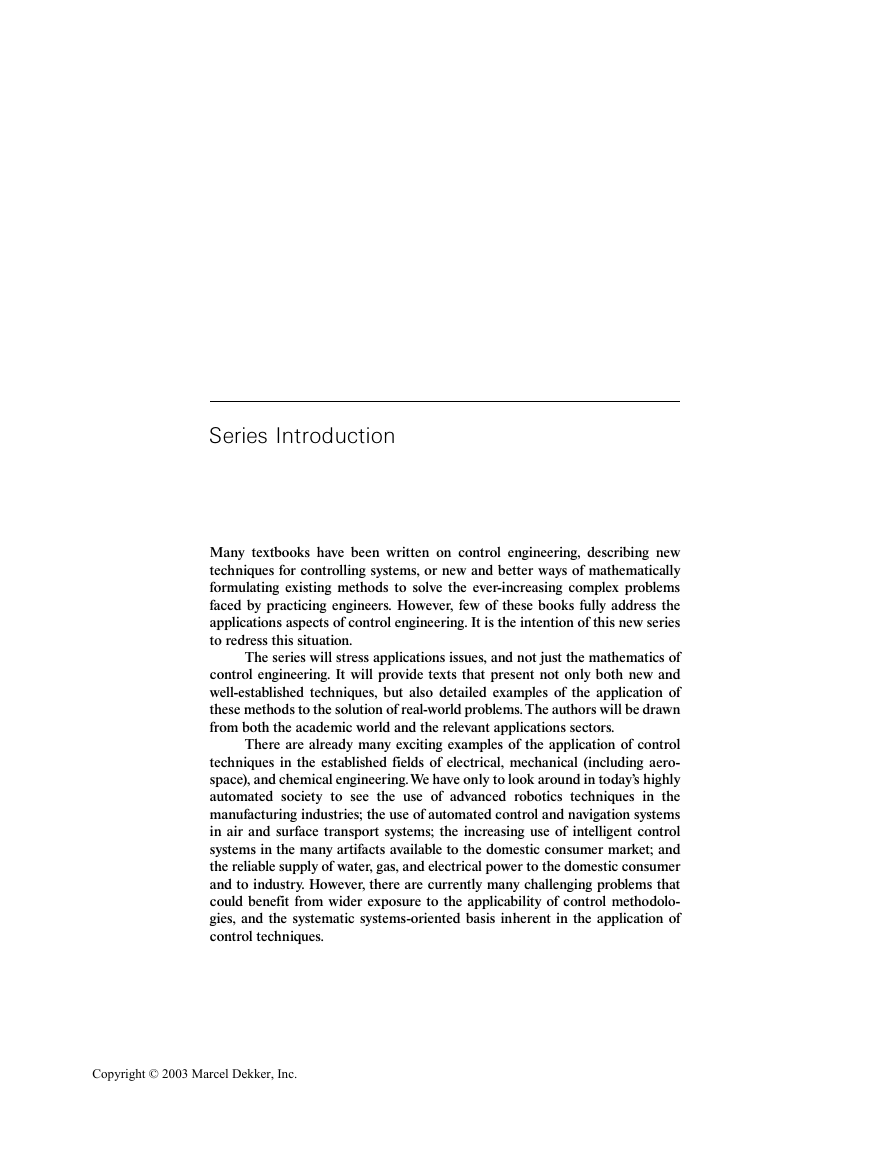
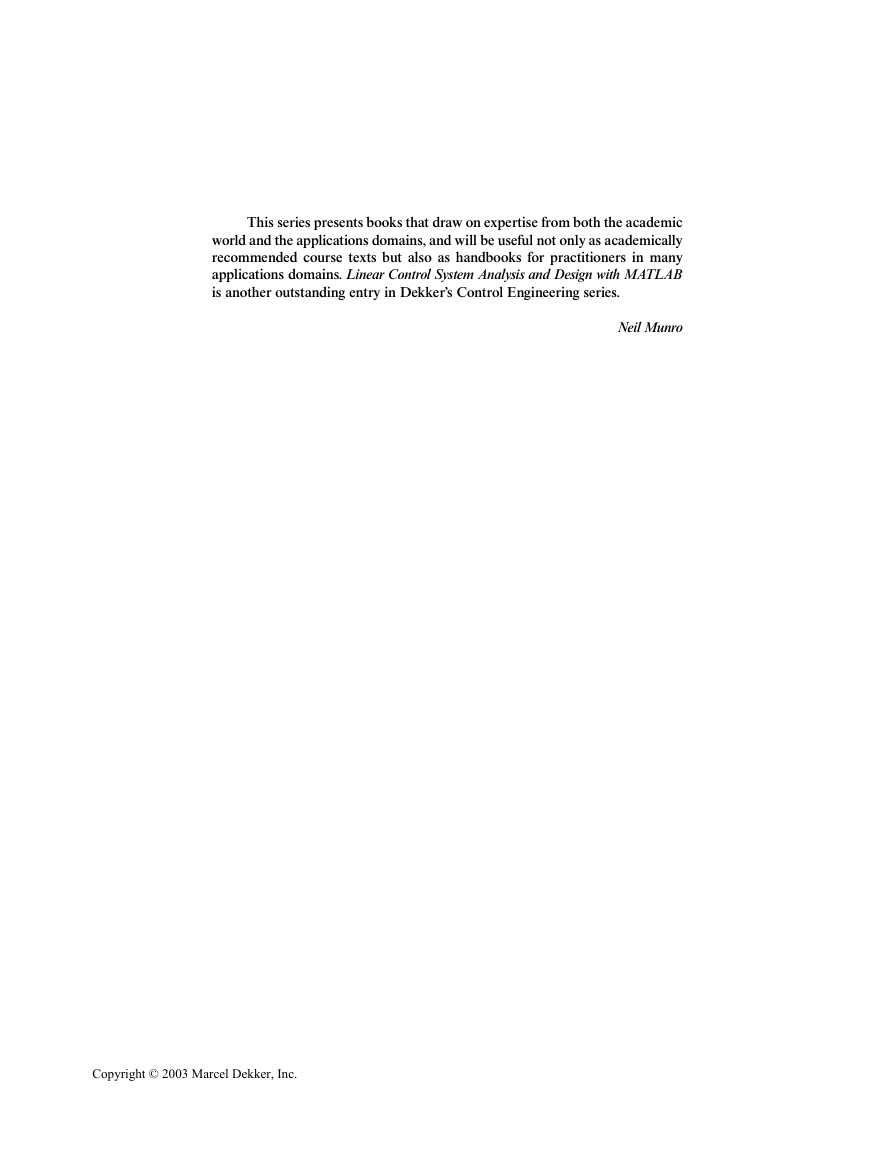
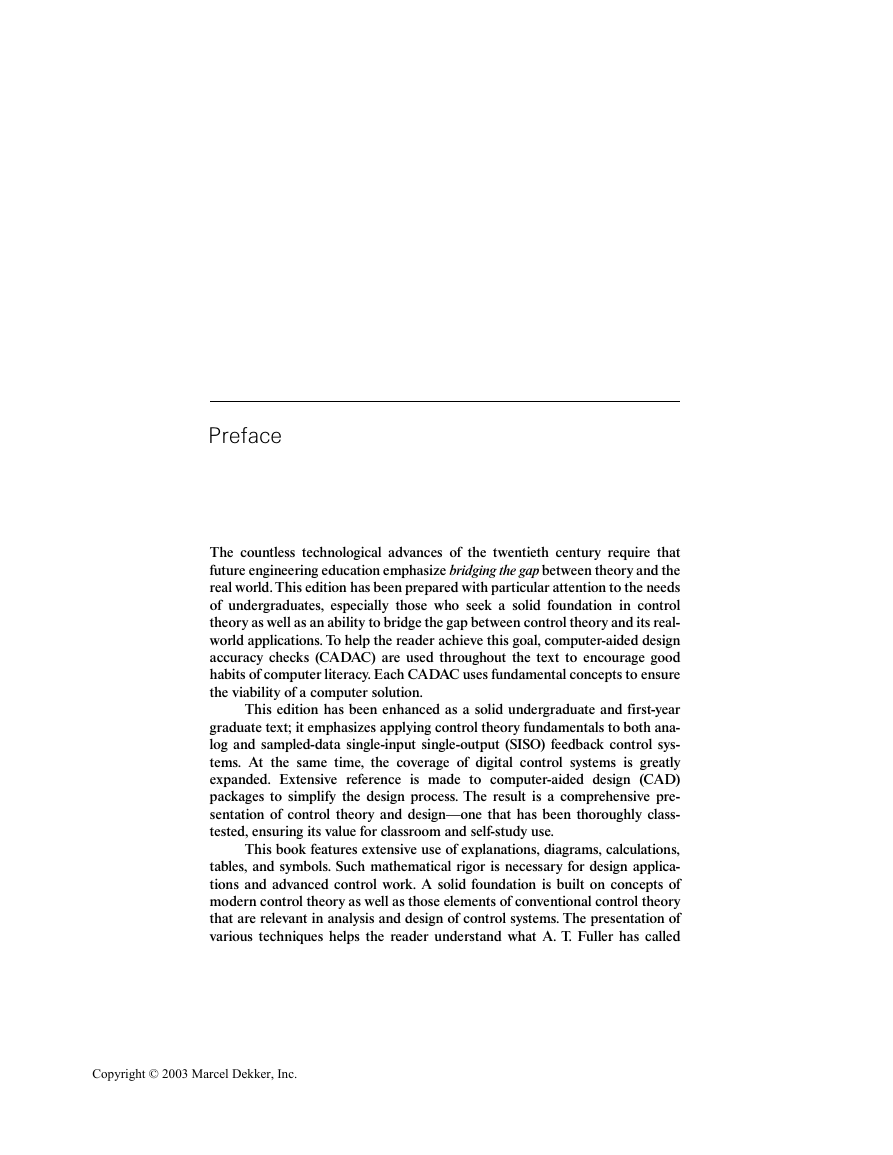
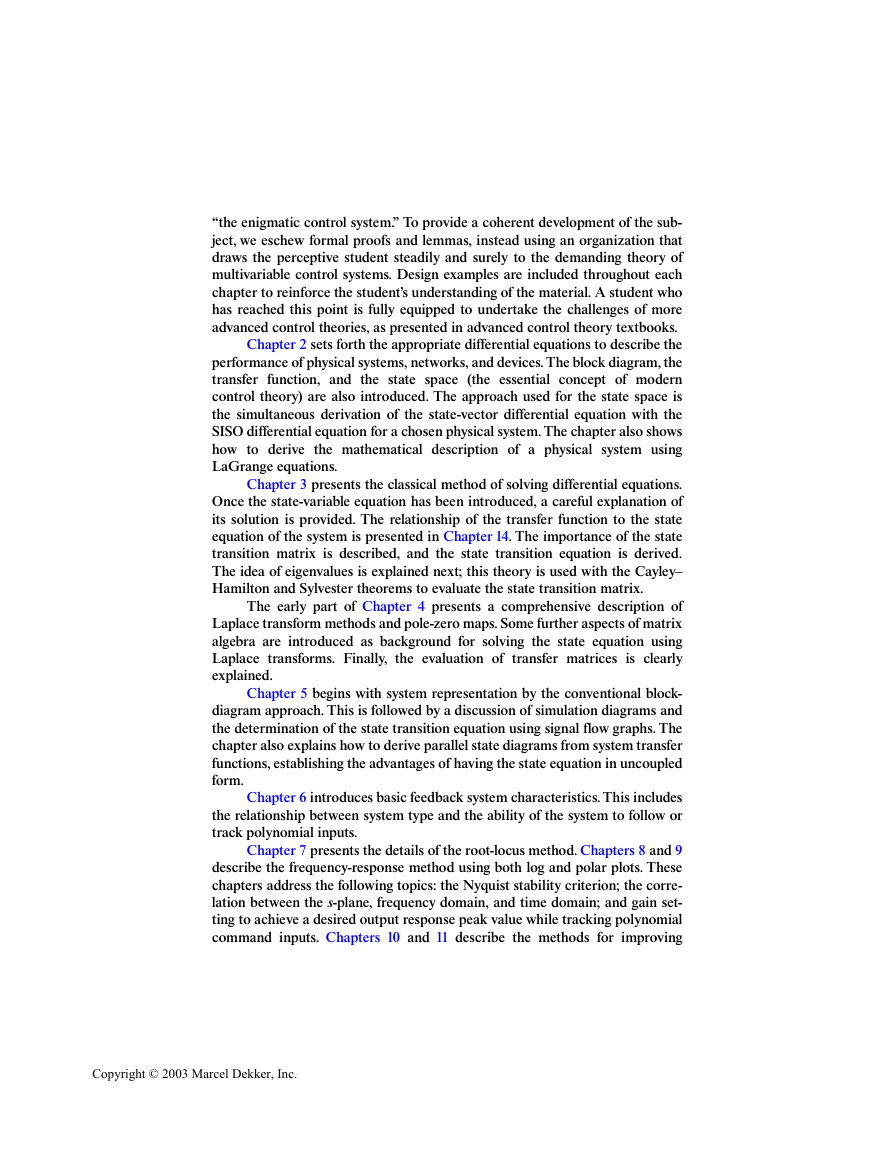








 2023年江西萍乡中考道德与法治真题及答案.doc
2023年江西萍乡中考道德与法治真题及答案.doc 2012年重庆南川中考生物真题及答案.doc
2012年重庆南川中考生物真题及答案.doc 2013年江西师范大学地理学综合及文艺理论基础考研真题.doc
2013年江西师范大学地理学综合及文艺理论基础考研真题.doc 2020年四川甘孜小升初语文真题及答案I卷.doc
2020年四川甘孜小升初语文真题及答案I卷.doc 2020年注册岩土工程师专业基础考试真题及答案.doc
2020年注册岩土工程师专业基础考试真题及答案.doc 2023-2024学年福建省厦门市九年级上学期数学月考试题及答案.doc
2023-2024学年福建省厦门市九年级上学期数学月考试题及答案.doc 2021-2022学年辽宁省沈阳市大东区九年级上学期语文期末试题及答案.doc
2021-2022学年辽宁省沈阳市大东区九年级上学期语文期末试题及答案.doc 2022-2023学年北京东城区初三第一学期物理期末试卷及答案.doc
2022-2023学年北京东城区初三第一学期物理期末试卷及答案.doc 2018上半年江西教师资格初中地理学科知识与教学能力真题及答案.doc
2018上半年江西教师资格初中地理学科知识与教学能力真题及答案.doc 2012年河北国家公务员申论考试真题及答案-省级.doc
2012年河北国家公务员申论考试真题及答案-省级.doc 2020-2021学年江苏省扬州市江都区邵樊片九年级上学期数学第一次质量检测试题及答案.doc
2020-2021学年江苏省扬州市江都区邵樊片九年级上学期数学第一次质量检测试题及答案.doc 2022下半年黑龙江教师资格证中学综合素质真题及答案.doc
2022下半年黑龙江教师资格证中学综合素质真题及答案.doc